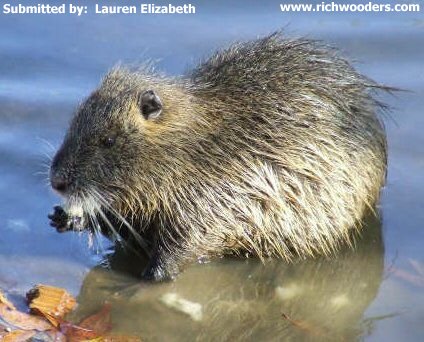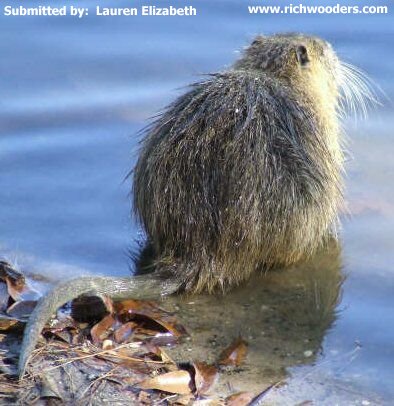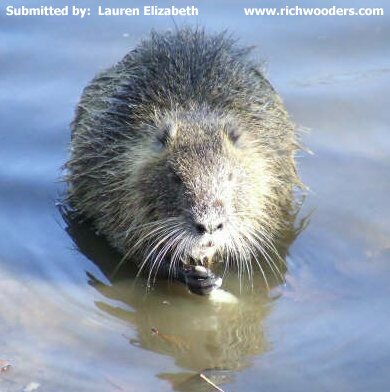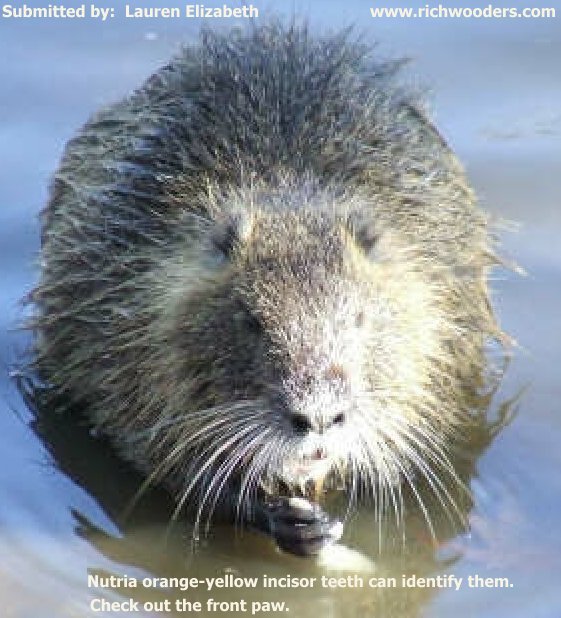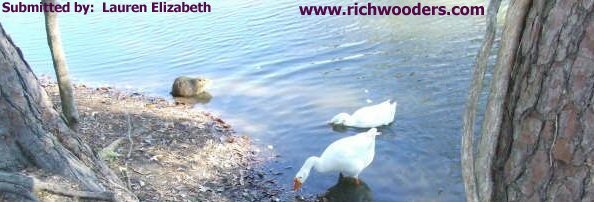Nutria in West VirginiaFact or Fiction Nutria in WV.The Scuttle Butt that I have been told was the nutria have not been sited in West Virginia but a risk of invasion is possible from neighboring states of Maryland and Virginia where nutria expanded into the State from North Carolina. Nutria are large, semiaquatic rodents that are native to South America. They have brown fur with small ears, webbed hind feet, and a long, lightly haired tail. Wild nutria may weigh up to 20 pounds. Nutria live along the banks of lakes, marshes, ponds, and rivers. They are surface-feeding herbivores that can be extremely destructive to marsh vegetation. These powerful animals forage directly on the vegetative root mat, leaving the marsh pitted with digging sites and fragmented with deep swim canals.
TOPNutria can be mistaken for Muskrat
These rodents can be mistaken for another widely dispersed swimming rodent that occupies the same wetland habitats, the muskrat. The muskrat, however, is smaller, more tolerant of cold climates, and has a laterally flattened tail that it uses to assist in swimming, where as the tail of a nutria is long, round, and thin.
The problems with nutria as non-native species, they have high reproductive capacity and they feed almost entirely on vegetation, removing habitat for native species, especially muskrat. They are opportunistic feeders with an extremely varied diet and nutria also eat crops, lawn grasses, and ornamentals adjacent to aquatic habitats.. They consume about 25% of their body weight daily. Nutria are primarily nocturnal (active at night), with peak activity occurring near midnight. When food is abundant, nutria rest and groom during the day and feed at night.
TOPHow fast do nutria reproduce?
Nutria are highly prolific and breed all year. Reproductive peaks occur in late winter, early summer, and mid-autumn. Reproduction and survival may be influenced by extreme weather conditions. Nutria reach sexual maturity at four to six months. Sexually mature male nutria can breed throughout the year. Females are pregnant from 128 to 130 days, and are ready to breed within forty-eight hours after giving birth. Litters average four to five young; however, nutria can have up to thirteen young per litter and may have three litters per year. Young are born fully furred and active, weighing 8 oz. at birth. They can swim and eat vegetation shortly thereafter, still feeding on mother's milk for up to eight weeks. The female's teats are located high on her sides to allow the young to suckle while in the water. Within five days of life, nutria can survive away from the mother.
TOPThe front paws of the nutria are able to grasp materials much like human.TOPThe actual size of a nutria
The nutria, Myocastor coypus, No wonder there were so many nutria around, bred on farms throughout the southern US in an attempt to establish a fur farm industry. Many of the fur farms failed in the late 1940s because fur prices fell and nutria did not reproduce well in captivity. Many nutria were released into the wild. Nutria were first imported into the United States between 1899 and 1930.Identifying the Aquatic Rodents Nutria.Beaver-sized incisors Powerful forefeetWebbed hind feetBright orange-yellow incisor teeth A long, lengthy, lightly haired tailWeigh up to 20 pounds in the wildThey are surface feeding Nutria are large, semiaquatic rodents They have brown fur with small earsNutria live along the banks of lakes, marshes, ponds, and rivers.Meat is lean and low in cholesterolWith their heads barely above the water’s surface they may be mistaken for beaver.Their small, black, unwebbed front feet are much smaller than their hind feet.Feral populations are established in several statesMyocastor coypus Common Name: nutriaNative Range: southern South America
Other States that have wild Nutria population.
Tennessee: The first nutria was observed in 1996; there is a small wild population which is most likely from range expansion. Alabama: Brought into Alabama by the Alabama Department of Conservation in 1949 as weed control agents, They now have a viable feral population.Arkansas: Imported into Arkansas in the late 1940s as weed control agents and by range expansion from Louisiana, They are now feral throughout much of the State.Colorado: Nutria were imported into Colorado for fur farming, and a small feral population is present.Delaware: Nutria present, most likely range expansion from Maryland.Florida: Nutria were introduced into Florida in the 1950s for fur farming. They have escaped captivity, or were released, and are now feral. Georgia: Nutria were introduced into Georgia for weed control by State and Federal agencies. They are now feral there.Louisiana: First introduction near New Orleans in the early 1930s and 1938 for fur farming; the nutria escaped in 1940 over fences damaged by a hurricane. Feral nutria in the State and is controlled by trapping and alligators.Mississippi: Nutria are in Mississippi because of range expansion from LouisianaNew Mexico: Introduced for fur farming; they are feral but their populations are small. North Carolina: There is a viable feral population of nutriaOklahoma: Recorded in Oklahoma and are present in low numbersOregon: Imported for fur farming in 1937; some escaped and feral nutria were officially recorded as early as 1941. Currently a viable wild population exists.Texas: A hurricane is thought to have scattered nutria into East Texas from Louisiana in 1941; however, there might have been some direct releases into the marshes of east Texas as well. By 1979 nutria were recorded in the trans-Pecos area of Texas.Washington: A feral population is present.SightingsWest Virginia: Date: Mar 25, 2010 12:50 PM
Hello I ran across your webpage as I was trying to figure out what this animal was in my pond. After I realized this creature was not a beaver due to the tail being long, round, and about 12 inches in length (rough estimate), I began to be quite curious as to what it was. So of course I googled it and found your site. I am 100% proof positive that we had Nutria in our pond in Preston County, Reedsville, WV. He did come out and eat grass on the bank by our pond along with eating what looked like part of some of our cat tails. I only wish I could have a good enough camera to snap a picture of him from our home so that I could send this to just make sure but unfortunately the poor little creature was a bit timid and every time we tried to walk down the hill toward the pond he would swim back by the spring that feeds the pond its fresh water and we were afraid he would leave so we left him alone and I observed him from binoculars out of a window. I just wanted to send this email to let you to let you know one Nutria has been spotted. Thank you for all of your information on your webpage.
Sincerely,
Rebecca Sines
Petersburg Virginia: Date: Apr 21, 2010 11:10 PM
I live in Petersburg Virginia, behind our house is a large drop off to a creek or water run off, not sure exactly but its heavily treed. Any way a few months ago I went to put trash in the can out back and saw this large brown creature running… we have a big opossum but this wasn't him. Then I went after him to see more clearly, I though it was a beaver but, its tail wasn't a beaver tail at all... I told a few people about it and how it looked like a beaver, squirrel, bunny, rat type thing but I had never seen any thing like it before (and I used to do wild life rescue in Florida) I happened to see something on a Nutria on TV so I looked it up and I think that's when is living out back. Have you had many reports of them here in Virginia?
Keli Bingham
Webmaster's Note!
There are confirmed reports of nutria from the south of Virginia Beach and In the Chesapeake Bay watershed.
General references:
(1) U.S. Fish and Wildlife Service
(2) OVERSIGHT HEARING ON PILOT PROGRAM TO CONTROL NUTRIA AT THE BLACKWATER NATIONAL WILDLIFE REFUGE IN MARYLAND
(3) U.S. Geological Survey
Web Site Hosted by [ Billybob and www.richwooders.com] 
 (Previous) (Previous)
If you should see a Nutria in West Virginia enjoy the moment. But be sure e-mail us your pictures and where the sighting took place....... |
